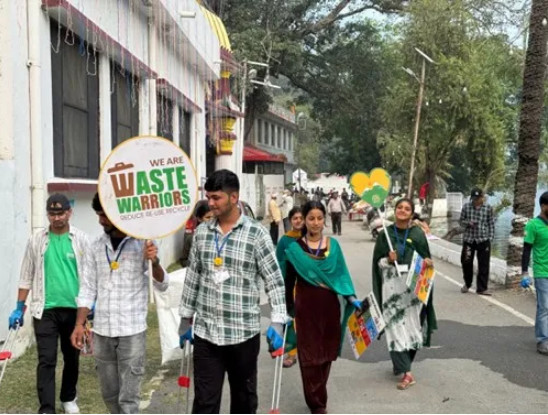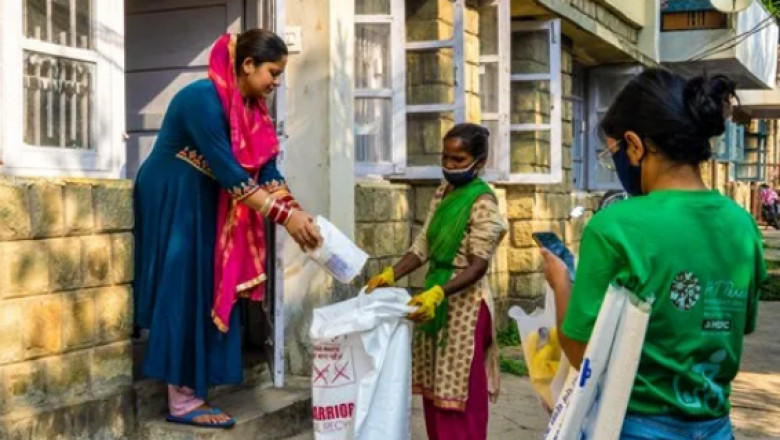views
An easy beginning to a sustainable life
Think of a typical day. Plastic wrappers from snacks, shopping bags, and takeaway containers often land in a pile that seems to disappear once you throw it in the bin. But in reality, it doesn’t just “go away.” Unmanaged waste is a growing threat to fragile ecosystems like those in Himachal Pradesh and Uttarakhand.
Start at Home: Easy Steps Toward a Waste-Free Life
A lot of people feel overwhelmed when it comes to reducing waste. But the truth is, you don’t need a grand gesture—small changes add up over time.
Here are a few easy practices to get started with-
- Say no to single-use plastics: Carry a cloth bag for groceries or a reusable water bottle when you’re out.
- Get creative with reusable: Repurpose glass jars as storage containers or use old T-shirts as cleaning rags.
- Segregate your waste: It’s simple but so effective. Separate recyclables, compost organic waste, and keep only the absolute non-recyclables for disposal.
- Donate clothes and toys: Instead of throwing them away, pass on gently used items to local charities, shelters, or NGOs. This reduces waste and helps those in need.
- Organize or join clothes swaps: Host a swap with friends or participate in community events to exchange pre-loved items and give them a second life.
- Shop groceries in bulk: Buying from wholesale shops or stores that allow you to bring your containers minimizes the use of single-use plastic packaging.
Waste Warriors takes these principles and amplifies them through workshops and clean-up campaigns. Their goal is simple—empower people to take control of their waste and protect the environment.
Back in 2012, Waste Warriors began as a grassroots effort. Today, they’ve grown into a non-profit organization tackling waste management in some of India’s most scenic yet vulnerable regions.
Their story is inspiring because it’s rooted in action:
- 5,570+ metric tons of waste diverted from landfills, thanks to recycling
- 1,60,00+ people engaged in awareness drives, clean-up events, and behavior change campaigns.
- 600+ businesses enabled to be cleaner and responsible with waste disposal
Beyond just cleaning up, Waste Warriors is influencing systemic change—whether it’s working with local governments to develop waste management solutions or collaborating with CSR initiatives to drive social impact in marginalized communities. Read more about Waste Warrior’s impact over the past 12 years.

Volunteer with Waste Warriors
One of the best ways to support Waste Warriors is by rolling up your sleeves and joining their team. Whether you’re hiking through the Himalayas collecting trash or hosting recycling workshops in schools, there’s something meaningful for everyone.
Volunteers help with:
- Leading clean-up drives to protect scenic trails.
- Teaching waste segregation in local communities.
- Supporting projects that connect waste pickers to opportunities, fostering rural livelihoods.
It’s not just about the work—it’s about becoming part of a movement that’s building a cleaner, greener future. You can follow this link and fill up a simple form to express your interest to volunteer with Waste Warriors.
Why Your Support Matters
At its core, Waste Warriors is about community-driven solutions. When you support them, you’re enabling change at a grassroots level, whether it’s through better waste collection services, recycling programs, or empowering communities to adopt sustainable practices.
Together, We Can Make a Difference
The next time you’re about to toss something “away,” think about where it ends up. Imagine the impact if we all decided to Reduce, Reuse, and Recycle a little more each day. Together with organizations like Waste Warriors, we can protect the environment, one small step at a time.
So what are you waiting for? Start today—reduce your waste, spread the word, and join the movement to create a sustainable future.
Waste Warriors is on an ambitious journey to make the Indian Himalayan region clean – one mountain at a time. Join Waste Warriors in their mission for sustainability in India and help protect the natural beauty of the Indian Himalayan region. Read more about their work here and be a supporter of this systemic battle.
- As already discussed by my fellowmate regarding the significance of the Rights of Nature, I would like to emphasize that this ecocentric approach represents a crucial step towards achieving the Sustainable Development Goals. Recognizing the Rights of Nature fosters a paradigm shift toward climate-smart and environmentally sound governance by adopting principles and practices aimed at protecting the environment. This marks a transition from a dominion-based relationship with nature to one grounded in mutualism. By allowing destructive practices like fracking, mining, and factory farming, current environmental regulatory frameworks essentially legalize environmental harm. Rights of Nature laws, on the other hand, provide a framework that puts ecosystem protection first and gives communities the authority to oppose harmful developments. In 2006, for example, Tamaqua Borough in Pennsylvania became the first American municipality to enact such laws, establishing a precedent for acknowledging the legal rights of nature.
In Bangladesh, the Turag River was declared a living entity, granting it legal personhood under the National River Conservation Commission. This recognition was accompanied by promises of rapid action to safeguard the river. However, challenges persist, as many water bodies in the country remain “dead” due to pollution from the indiscriminate dumping of industrial and human waste. Similarly, Ecuador has been a pioneer in integrating the Rights of Nature into its legal framework. A notable example occurred in 2021 when the Ecuadorian Constitutional Court revoked mining permits in Los Cedros, a cloud forest in the Andes known for its rich biodiversity. The court ruled that these permits violated not only the rights of local communities, such as the right to clean water and a healthy environment but also the inherent rights of the forest itself.
While recognizing the Rights of Nature is a significant step, its effective implementation often depends on aligning political interests and human actions with ecological goals. This underscores the need for strong governance and enforcement mechanisms to ensure that such legal frameworks are not undermined by competing interests or insufficient action.
- As highlighted above, the Rights of Nature are always in alignment with human interests. The Rights of Nature serve as a bridge between environmental preservation, Indigenous rights, and human rights, and they are highly compatible with human interests. However, to maintain planetary habitability, ecosystems’ rights must occasionally take precedence because they provide humanity with vital life support. The human right to a healthy environment has been acknowledged by countries such as Finland, France, and Spain, which emphasise that securing robust legal protections for nature itself is essential to achieving this right.
Such disputes can be settled with the aid of well-defined legal frameworks that incorporate ecological thresholds and promote coexistence. Interspecies rights present another challenge, as conservation initiatives frequently give apex predators precedence over the interdependent functions of every species
in an ecosystem. This imbalance can be addressed by policies that take a comprehensive approach and are backed by traditional knowledge and community involvement. Furthermore, the Rights of Nature contradict conventional wisdom regarding sustainable development, which frequently ignores ecological health in favour of massive projects like mining or dam construction. Development objectives and environmental priorities can be matched by implementing decentralised legal frameworks and strengthening environmental impact assessments. For the Rights of Nature to be implemented effectively, I feel coalitions among stakeholders must be formed in order to identify needs and challenges. This ensures that solutions are inclusive and balanced.






















Comments
0 comment